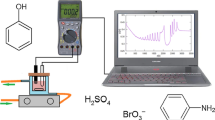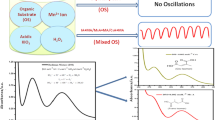Abstract
The system KSCN–H2O2–CuSO4–NaOH, also known as the Orbàn–Epstein oscillatory reaction, is exposed to external perturbations by several phenolic compounds: catechol, resorcinol, hydroquinone, 2,5-dihydroxybenzoic acid, 2,6-dihydroxybenzoic acid, 2,3-dihydroxybenzoic acid, 2,4-dihydroxybenzoic acid, 3,4-dihydroxybenzoic acid, 3,5-dihydroxybenzoic acid, caffeic acid, and ferulic acid. As a result of the performed perturbation in most examined cases, oscillations have been inhibited for some characteristic time, and resumed afterwards. The evaluated inhibition time is typical for each substance and strongly dependent on its concentration. The chemical mechanism of the interaction between the Orbàn–Epstein system and phenolic compounds is briefly discussed. Numerical simulations are performed using the original Orbàn–Epstein model with 30 reactions, extended by three reactions describing the interaction with inhibitory substances. The rate constants of three added reactions are adjusted to fit experimental inhibition times, and compared among used compounds. The observed effects are discussed further in relation with the bond dissociation enthalpy theory. Unlike other tested compounds, 2,5-dihydroxybenzoic acid remains off from predicted order of activity.





Similar content being viewed by others
References
Bray WC (1921) A periodic reaction in homogeneous solution and its relation to catalysis. J Am Chem Soc 43:1262–1267
Bray WC, Liebhafsky HA (1931) Reactions involving hydrogen peroxide, iodine and iodate ion. I. Introduction. J Am Chem Soc 53:38–44
Belousov BP (1959) in: Sbornik Referatov po Radiatsinnoi Meditsine (1958, Medgiz, Moscow), pp 145–147 (in Russian). English translation in: Field RJ, Burger M (1985) (ed) Oscillations and travelling waves in chemical systems, Wiley, New York, pp 605–613
Zhabotinsky AM (1964) Periodic course of oxidation of malonic acid solution. An investigation of the kinetics of the reaction of Belousov. Biofizica 9:329–335 (in Russian)
Zhabotinsky AM (1964) Periodic liquid-phase oxidation reactions. Doklady Akademii Nauk SSR 157:392–395 (in Russian)
Briggs TS, Rauscher WC (1973) An oscillating iodine clock. J Chem Educ 50:496–496
Orbán M (1986) Oscillations and bistability in the Cu(II)-catalyzed reaction between H2O2 and KSCN. J Am Chem Soc 108:6893–6898
Luo Y, Orbán M, Kustin K, Epstein IR (1989) Mechanistic study of oscillations and bistability in the Cu(II)-catalyzed reaction between H2O2 and KSCN. J Am Chem Soc 111:4541–4548
Epstein IR (1987) Patterns in time and space—generated by chemistry. Chem Eng News 65:24–36
Sharma KR, Noyes RM (1976) Oscillations in chemical systems. 13. A detailed molecular mechanism for the Bray-Liebhafsky reaction of iodate and hydrogen peroxide. J Am Chem Soc 98:4345–4361
Furrow SD, Cervellati R, Amadori G (2002) New substrates for the oscillating Briggs-Rauscher reaction. J Phys Chem A 106:5841–5850
Olexova A, Marakavova M, Melichercik M, Triendl L (2010) Oscillatory system I –, H2O2, HClO4: the modified form of the Bray-Liebhafsky reaction. J Phys Chem A 114:7026–7029
Schmitz G (2010) Iodine oxidation by hydrogen peroxide in acidic solutions, Bray-Liebhafsky reaction and other related reactions. Phys Chem Chem Phys 12:6605–6615
Stanisavljev DR, Milenković MC, Mojović MD, Popovic-Bijelic AD (2011) Oxygen-centered radicals in iodine chemical oscillators. J Phys Chem A 115:7955–7958
Milenković MC, Stanisavljev DR (2012) Role of free radicals in modeling the iodide-peroxide reaction mechanism. J Phys Chem A 116:5541–5548
Čupić ZD, Greco E, Cervellati R (2015) New Experimental and Mechanistic Investigation on the KSCN-H2O2-NaOH-Cu(II)-catalyzed oscillating system (Orbàn–Epstein reaction): inhibitory effects by diphenols. Int J Chem Kinet 47:82–92
Cervellati R, Furrow SD (2013) Effects of additives on the oscillations of the Briggs-Rauscher reaction. Russ J Phys Chem 87:2121–2126
Clarke BL (1980) Stability of complex reaction networks. In: Prigogine I, Rice SA (eds) Advances in chemical physics, vol 43. Wiley, New York, NY, pp 1–216
Clarke BL (1998) Stoichiometric network analysis. Cell Biophys 12:237–253
Čupić Ž, Marković V, Ivanović A, Lj Kolar-Anić (2011) Modeling of the complex nonlinear processes: determination of the instability region by the stoichiometric network analysis. In: Brennan CR (ed) Mathematical modelling. Nova Science Publishers Inc., New York, pp 111–178
Cervellati R, Hoener K, Furrow SD, Neddens C, Costa S (2001) The Briggs-Rauscher reaction as a test to measure the activity of antioxidants. Helv Chim Acta 84:3533–3547
Bielsky BHJ, Cabelli DE, Arudi RL, Ross AB (1985) Reactivity of HO2/O2 − radicals in aqueous solution. J Phys Chem Ref Data 14:1041–1100
Luo Y, Kustin K, Epstein IR (1988) Kinetics and mechanism of H2O2 decomposition catalyzed by Cu2+ in alkaline solution. Inorg Chem 27:2489–2496
Orbàn M, Kurin-Csorgei K, Ràbai G, Epstein IR (2000) Mechanistic studies of oscillatory copper(II) catalyzed oxidation reactions of sulfur compounds. Chem Eng Sci 55:267–273
Wisniewski A, Pekala K, Orlik M (2010) Kinetic model of the H2O2 − SCN−−OH−−Cu2+ oscillator and its application to the interpretation of the potentiometric responses of various inert electrodes monitoring the reaction course. J Phys Chem A 114:183–190
Gear CW (1971) Numerical initial value problems in ordinary differential equations. Englewood Cliffs Prentice-Hall Inc, New Jersey
Zazo JA, Casas JA, Mohedano AF, Gilarranz MA, Rodriäguez JJ (2005) Chemical pathway and kinetics of phenol oxidation by Fenton’s reagent. Environ Sci Technol 39:9295–9302
Pham-Huy LA, Hua H, Pham-Huy C (2008) Free radicals antioxidants in disease and health. Int J Biomed Sci 4:89–96
Wright JS, Johnson ER, Di Labio GA (2001) Predicting the activity of phenolic antioxidants: theoretical method, analysis of substituent effects and application to major families of antioxidants. J Am Chem Soc 123:1173–1183
Eckschlager K, Horsak I, Veprek Siska J (1974) Oxidation of metol, resorcinol and pyrocatechol with hydrogen peroxide, catalyzed by Cu2 + ions. Collect Czech Chem Commun 39:2353–2362
Milenkovic D, Jorovic J, Jeremic S, Dimitric Markovic J, Avdovic EH, Markovic Z (2017) Free radical scavenging potency of dihydroxybenzoic acids. J Chem. https://doi.org/10.1155/2017/5936239
Acknowledgement
Support from the Ministry of Education, Science and Technological Development of the Republic of Serbia, grants 172015 and 45001, is gratefully acknowledged.
Author information
Authors and Affiliations
Corresponding author
Rights and permissions
About this article
Cite this article
Cervellati, R., Greco, E., Blagojević, S.M. et al. Experimental and mechanistic study of the inhibitory effects by phenolics on the oscillations of the Orbàn–Epstein Reaction. Reac Kinet Mech Cat 123, 125–139 (2018). https://doi.org/10.1007/s11144-017-1306-8
Received:
Accepted:
Published:
Issue Date:
DOI: https://doi.org/10.1007/s11144-017-1306-8




